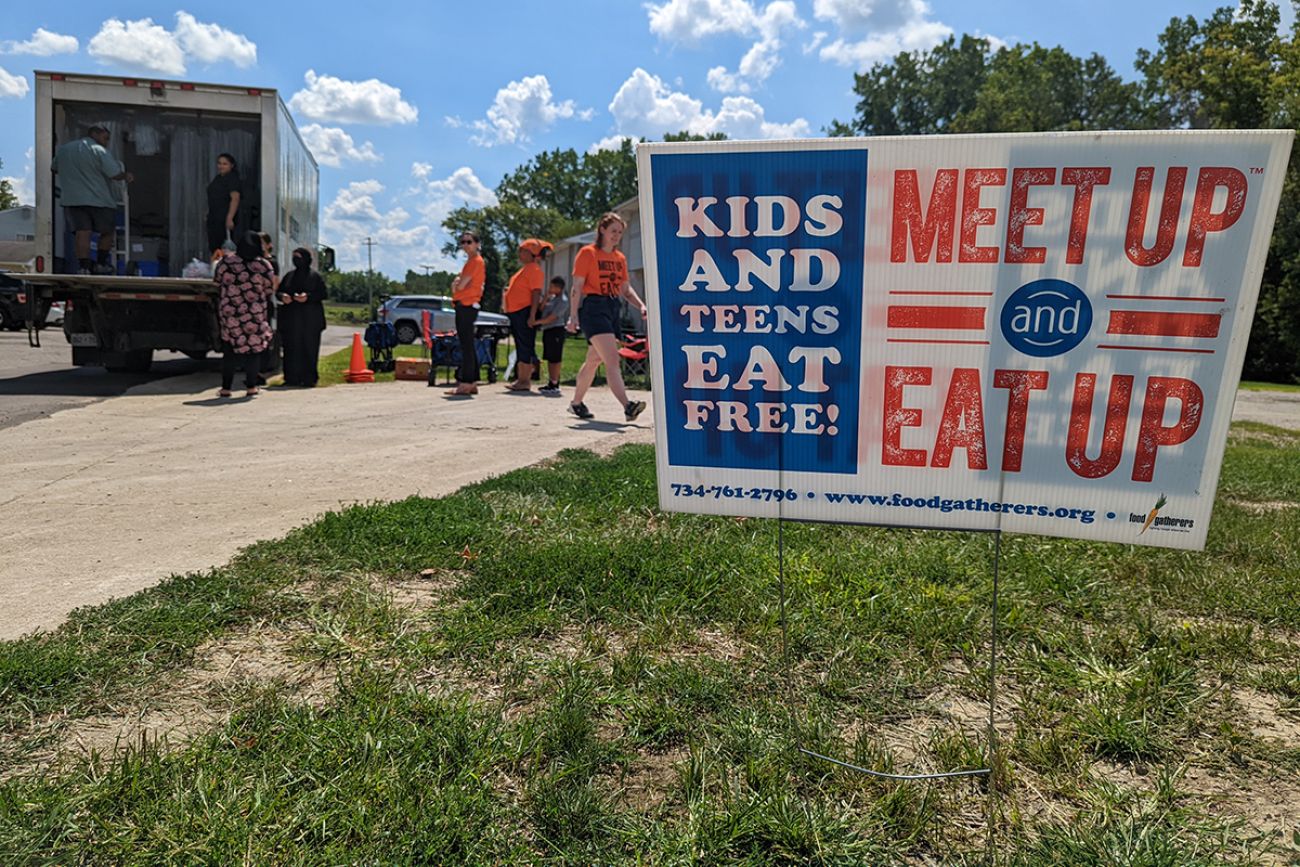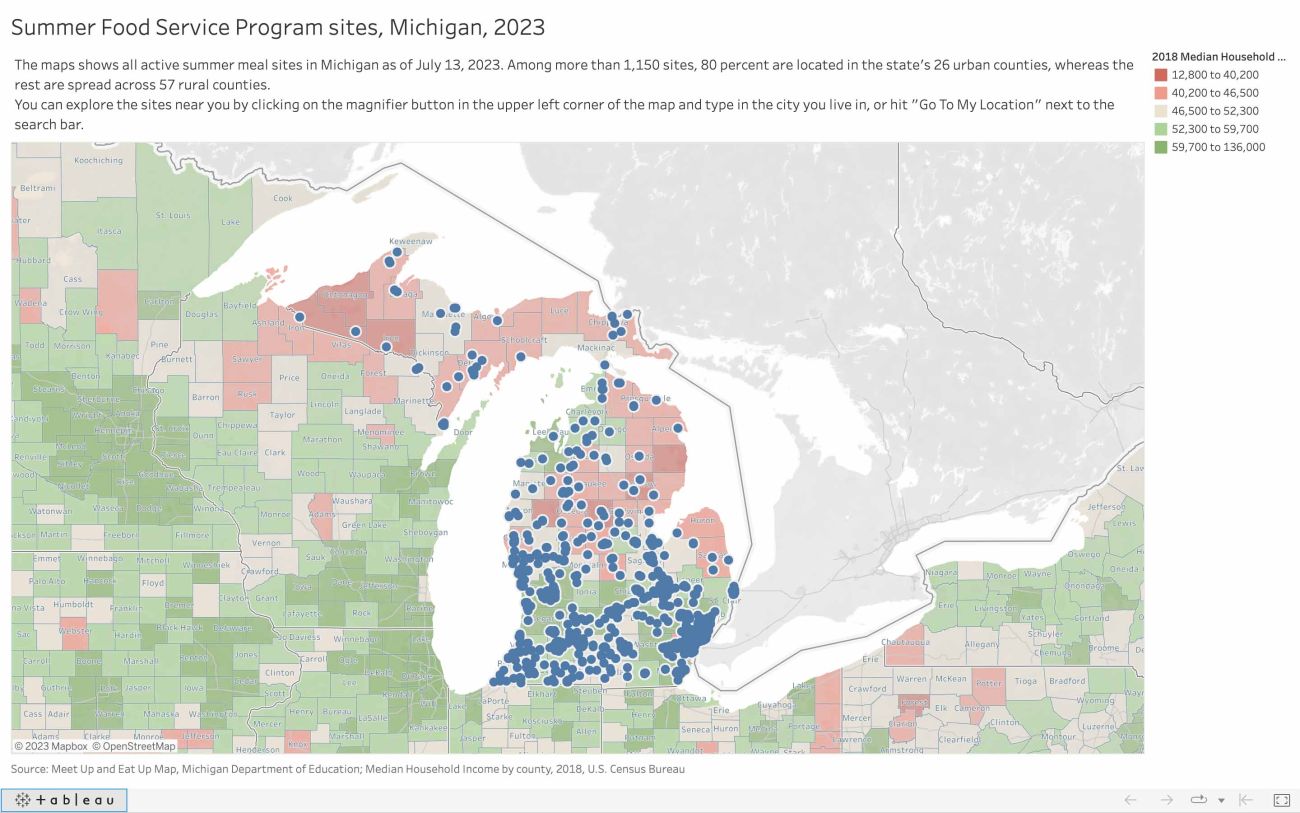In rural Michigan, need is great, but summer food programs are scarce

- Much of Michigan is rural geographically, but rural counties account for 20 percent of summer meal sites
- Expired pandemic benefits compounded the need for food assistance, research shows
- Experts: Lack of transportation, staffing constraints limit rural participation in summer meal programs
LANSING — In the small northern Michigan village of Lincoln, a local food pantry shut its doors indefinitely in June.
For Dan O’Connor, superintendent of Alcona Community Schools in the northeast Lower Peninsula, it meant one less tool to feed the county.
Alcona County has the state’s 10th highest rate of what’s known as “child food insecurity” — with 16.2 percent lacking consistent access to adequate amounts of food, according to statistics from Feeding America, a nonprofit network of food banks nationwide.
More than 60 percent of the district’s 700 students qualify for free or reduced price meals during the school year, state data shows.
Related:
- Food assistance cuts loom for 1.3 million Michiganders. No legislative action yet
- More Michigan families could qualify for food assistance for women, children
But the district does not have the staffers to keep students fed during the summer, O’Connor said. The district’s food service employees work nine months during the school year and may work other jobs during the other three, he said.
“It definitely can be challenging in small rural communities to navigate the workforce,” O’Connor said.
During summer breaks, local school districts, food banks and other nonprofits nationwide often sponsor summer meal sites through the U.S. Department of Agriculture’s summer food service program — a federally funded program that allows local sponsors to offer free meals to children and receive reimbursements afterward.
More than 1,150 active summer meal sites were spread across Michigan’s 83 counties as of July 13, according to the state’s Meet Up and Eat Up map. Another 200 sites have either stopped feeding kids or have yet to begin. Last year, 4 million summer meals were served at a cost of about $15 million, according to state figures.
But Alcona County is one of five Michigan counties — all rural — with no summer meal sites at all, the state map shows.
While almost 70 percent of all Michigan counties are rural, just 20 percent of all summer meal sites statewide are in rural counties, according to a Bridge Michigan analysis of the state’s summer meal map.

Here is a Bridge Michigan map of all active summer meal sites as of July 23 in Michigan. You can interact with the map and search for sites near you by clicking here. (Screenshot)
The disparity between the numbers of rural and urban sites tracks with the population differences in Michigan: Urban counties have five times the population and four times the summer meal sites than their rural counterparts in the state, Census data shows.
But needy families in rural Michigan still face big challenges in feeding children during the summer, because of travel and other logistical issues, said James Sears, an assistant professor at the Department of Agricultural, Food, and Resource Economics at Michigan State University.
“If you can just hop on a Wayne County bus for a couple of stops, go get your lunch, hop back on, that's a lot easier of an effort than having to convince a parent to drive you 20 miles to the next site … if you are in a rural county,” he said.
Some rural Michigan counties with the highest child food insecurity rates have the fewest summer meal sites, meaning that those with the greatest needs are often going without, according to the Bridge analysis of state data and statistics from Feeding America.
Alcona, Montmorency and Luce counties — all without a single summer meal site — are among the top 10 Michigan counties with the highest child food insecurity rates.
Roscommon County, with the highest child food insecurity rate at 22.3 percent, has only one summer meal site toward the county’s eastern border.
On average, there is one site every 75 square miles in urban counties, but only one site every 303 square miles in rural counties, Sears told Bridge after he analyzed the state data.
In urban counties, challenges exist as well. Some families live in counties designated as urban but are practically rural, said Bryan Van Dorn, supervisor of the state’s summer food service program at the Michigan Department of Education.
“You can go to Stockbridge, you can go to Leslie,” Van Dorn told Bridge in an interview last month, referring to a village and a city in Ingham County.
“There are areas within the county that very much would meet the definition of rural.”
Summer meal program participation spiked nationally in 2020 and 2021 because federal waivers expanded sponsors’ eligibility to serve grab-and-go meals and to serve summer meals in all areas, according to a January 2023 report by the Food Research and Action Center.
But the policies expired in June 2021, spurring concerns from experts that it would create a “hunger cliff” for children during the summer, when they need free meals the most. Researchers predicted participation would drop after the waivers expired, Education Week reported.
Michigan had a total of 2,180 summer meal sites in 2021 — the most since 2018, according to statistics Van Dorn provided. The total number of sites dropped to 1,380 in 2022 and 1,339 this summer, partly because some schools chose to participate in a different federal program to feed the kids during the summer, he said.
Other pandemic assistance that ended this year — such as the end of extra food assistance in March that affected 1.3 million Michiganders — compounded the summer feeding problem, said Kate Bauer, an associate professor in nutritional science at University of Michigan and lead researcher of Feeding MI Families, a project that surveyed 1,400 families statewide on their food needs.
Not all needy families take advantage of the summer meal program, and the shame associated with relying on food assistance is a huge barrier, Bauer said. Nationally, 30.4 percent of children who qualified for free and reduced-price school meals used the summer meal program in July 2021, according to a report by the Food Research and Action Center.
But without nutrition, children who go hungry in summer can have physical and mental problems and learning loss, Bauer said.
“These are critical periods where you are setting kids up for what could be chronic diseases later in life,” she said.
What could alleviate the summer feeding needs is the state’s summer Pandemic Electronic Benefits Transfer program, or P-EBT, Bauer noted.
The P-EBT program offers $120 per child for the whole summer to an estimated 900,000 Michigan participants in the National School Lunch Program. It requires a school meal application from parents to qualify for the program, according to food advocacy group No Kids Hungry Michigan.
More help is on its way. Due to a new federal law, families with children who qualify for free or reduced-price school meals will receive a monthly payment of $40 per child during summer months starting next year.
Michigan lawmakers also passed a $82 billion state budget last month, which includes $160 million to offer free school meals to all students starting next year. The funding does not cover summer months when school is out, but child care advocates welcomed the measure and argued it would help battle child hunger during the school year.
Rural challenges
With higher density, urban counties have the infrastructure to feed more people and often have more staffers who can operate free meal sites during the summer, said Sears, the MSU professor.
In sprawling rural counties, that becomes much harder, he said.
Alcona Community Schools has never served free summer meals on-site, said O’Connor, the superintendent.
Under federal law, only areas where 50 percent or more children are eligible for free or reduced price school meals can host summer meal sites. The requirement was waived during the pandemic, but the waiver expired in June 2021.
The two schools in Alcona County — Alcona Elementary School and Alcona Community High School — are not eligible to host summer meal sites, according to the USDA area eligibility map. The area has 48.8 percent of children who qualify for free and reduced price meals — just under the 50-percent mark, the map shows.
In rural counties, where students are more scattered, the area eligibility rule can eliminate locations that could otherwise serve needy families, Sears said.
During the COVID-19 pandemic, the Alcona school district took advantage of the federal waiver and offered grab-and-go bags for families twice a week in 2020 and 2021 via a drive-through, O’Connor said.
But the district stopped offering grab-and-go bags during the summer in 2022, as its new in-house food service director learned on the job and the district lacked staffing for the summer, he said.
“It just was kind of a perfect storm,” O’Connor said.
O’Connor said the school district hopes to serve summer meals next year. But even if it did, the sprawling geography of Alcona County makes it hard for students to get to the site, he said.
During the school year, the district runs eight bus routes that travel as much as two hours each way, with students traveling in a bus “starting 6:15 in the morning until 8 or so,” he said.
“Our schools essentially serve this entire county. It’s 45 minutes to an hour to get from one side to the other, and you are not going to pass through a town of more than 500 people,” O’Connor said.
Sears, the MSU professor, said the lack of food sites creates a “spiraling effect”: If sites are underutilized — for whatever reason — sponsors of them are less likely to bring back the program the next year.
“Suddenly there are fewer resources available in the future for the kids in these rural areas who need it,” he said.
And that eliminates a lot of food options for rural families, said Bauer, the UM professor and researcher.
“It’s like that Swiss cheese analogy, right?” she said. “These rural families, they don’t have enough layers of cheese. There’s only one food pantry or there’s only one mobile truck once a month, and in Detroit or Grand Rapids, people have so much choice.”
Need is great in cities too
In Washtenaw County, the nonprofit food bank Food Gatherers has set up 14 summer meal sites this year. The group serves roughly 60,000 meals a year that reach 1,200 kids, said Markell Miller, director of community food programs at the group.
That is about one-quarter of the 4,760 children in the county considered food-insecure, according to data from Feeding America.
Most of Food Gatherers’ sites are in Ypsilanti, with two in Dexter and one in Belleville, according to the group’s flyer.
Miller acknowledged the group won’t be able to reach all families. Similar to challenges in rural counties, the group is bound by the area eligibility constraints and cannot staff sites to serve families living in rural pockets of the county, she said.
“There are definitely areas in Washtenaw County where there are families who participate in school meals (during the school year), and they can't participate in the summer because the area they live in is not area eligible,” she said.
In Clinton County, which is designated as urban because of its proximity to Lansing, one summer meal site is all there is for roughly 1,000 food-insecure children, according to Feeding America estimates.
Van Dorn, who oversees the summer meal program at the Michigan Department of Education, said the state is working with the USDA and may have more flexibility next year to better address the needs in rural pockets.
“If you get into Clinton County, for all intents and purposes, it’s a rural county,” he told Bridge. “We will have the flexibility to define that a little bit better for next year and maybe make some eligibility decisions for (sites in those counties).”
See what new members are saying about why they donated to Bridge Michigan:
- “In order for this information to be accurate and unbiased it must be underwritten by its readers, not by special interests.” - Larry S.
- “Not many other media sources report on the topics Bridge does.” - Susan B.
- “Your journalism is outstanding and rare these days.” - Mark S.
If you want to ensure the future of nonpartisan, nonprofit Michigan journalism, please become a member today. You, too, will be asked why you donated and maybe we'll feature your quote next time!




